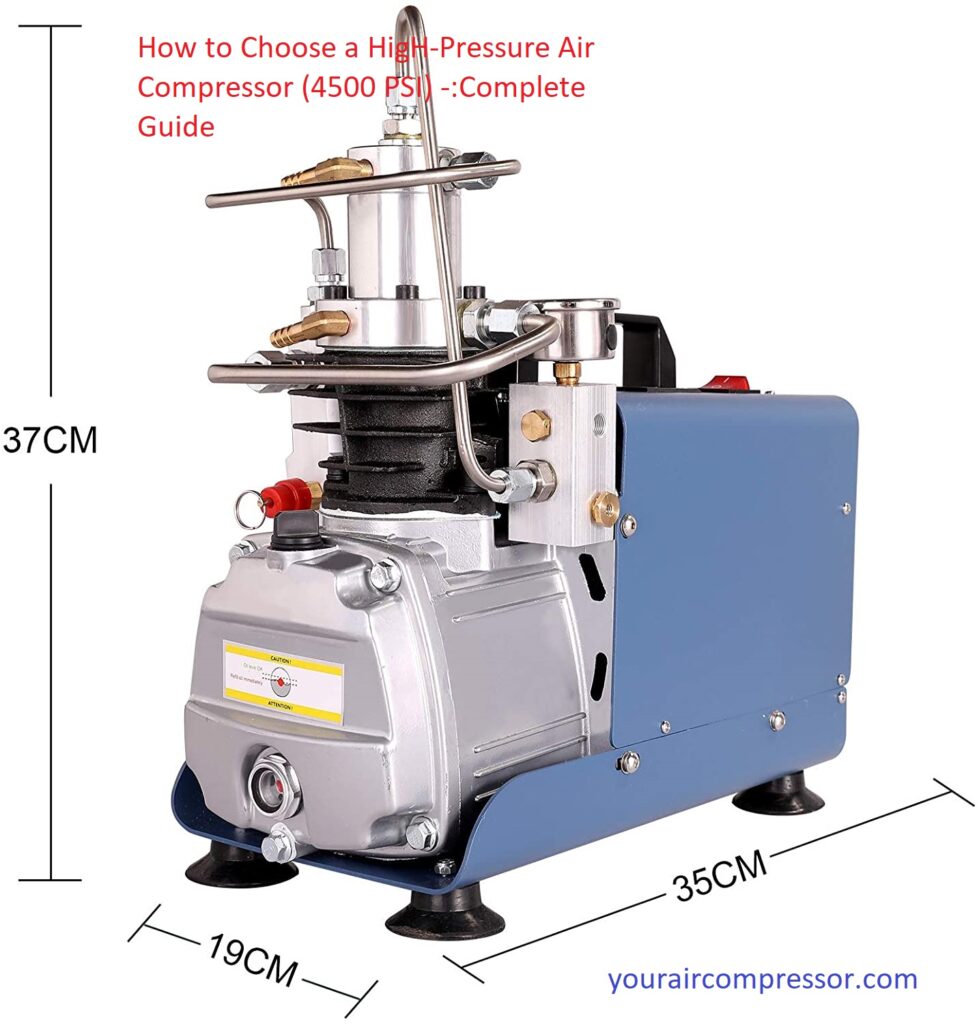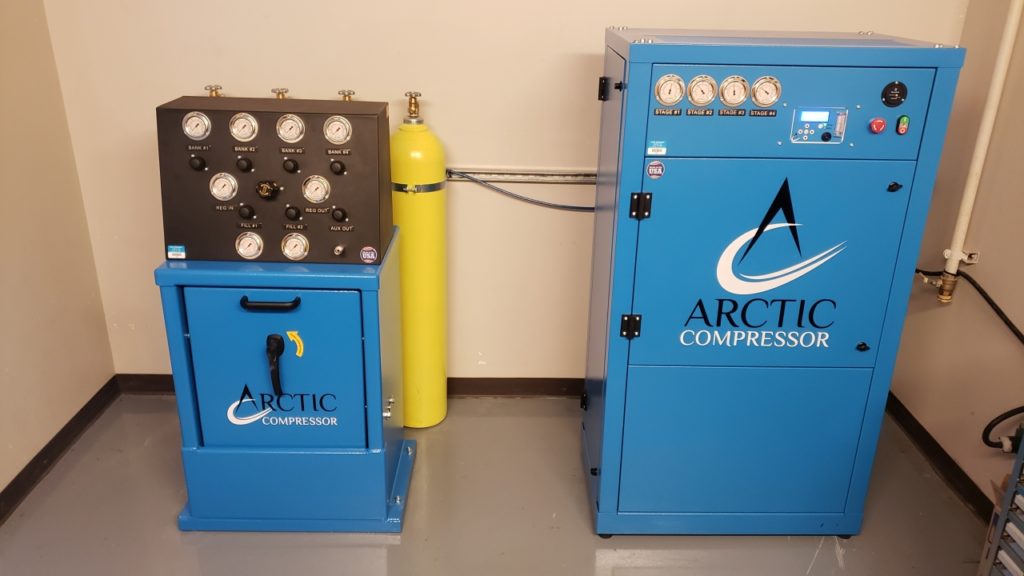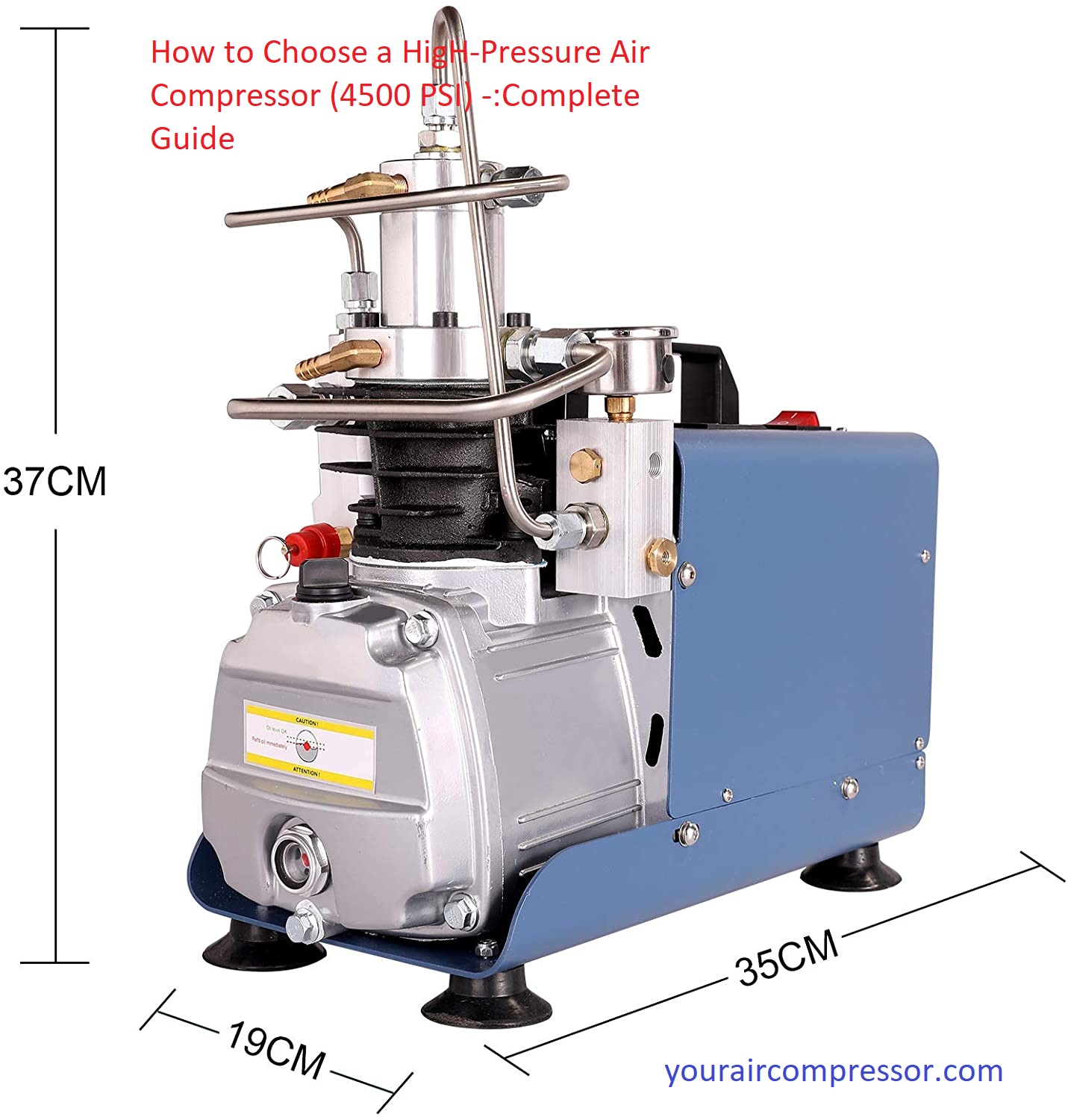 Are you looking for a reliable high-pressure air compressor to get your job done quickly and efficiently? If so, you’re in the right place.
Are you looking for a reliable high-pressure air compressor to get your job done quickly and efficiently? If so, you’re in the right place.
In this article, we’ll guide you through the process of choosing the best 4500 PSI air compressor for your needs. We’ll look at features and benefits, cost, maintenance requirements and more.
An air compressor is an essential piece of equipment used in a variety of industries including automotive and other manufacturing, woodworking, medical and military applications, painting and tire service. High-pressure air compressors provide the power to operate tools or machinery that require pressurized air up to 4500 PSI.
Choosing the best high-pressure air compressor for your application requires some research into the different types of compressors available and their features. The most important considerations when selecting a high-pressure air compressor include: pressure ratings, size of the storage tank, motor power, portability needs and safety features.
In this guide we will explore the types of high-pressure air compressors available on the market today, explore their features so you can make an informed decision when purchasing one.
Explanation of high-pressure air compressors
High-pressure air compressors are specialized pieces of machinery used to compress air to a pressure greater than 200 PSI, often up to 4500 PSI or more. These types of compressors are not common, so it is important to understand their features before making a purchase.
High-pressure air compressors are heavier and larger than low-capacity models due to their more complex construction, and they typically require longer for pressurization times as well as greater amounts of maintenance. Specialized components such as pressure relief valves, high capacity filters, start-up delay switches, and safety shutoffs are often added to these types of machines in order to protect both the compressor and the operator from potentially dangerous situations resulting from high levels of pressurized air.
When choosing the correct high-pressure air compressor for your needs, it is essential to understand the various types available on the market. Some models operate at continuous flow, others provide variable levels up to a set level or a fixed pressure setting depending on the type of usage requirements. Additionally there are also multiple fuels used in these types of machines such as gasoline and diesel which power both electric and pneumatically driven systems. It is also important consider noise levels generated by these models when selecting one – this will vary greatly depending on the size of the machine and any special soundproofing that may have been added during production.
Importance of choosing the right air compressor
Choosing the right air compressor is essential to the operation of any high-pressure system. Air compressors are designed to convert atmospheric pressure into a high-pressure, compressed stream. Different sizes and types of compressors are available, and the right selection can save money, as well as improve performance.
When selecting an air compressor for a 4500 PSI (33 bar) system, it is necessary to consider the delivered flow rate, maximum pressure rating of the equipment, outlet pressure range and safety considerations. The proper size and type of air compressor must be chosen to meet these parameters in order to support the required operation.
The flow rate dictates how quickly you can replenish a pressurized vessel or system with fresh air. Higher levels of pressure require larger amounts of compressed volumes for recharge figures which reflect in the needed delivery rate from an air compressor. It is equally important that there is enough stored air even when unexpected demand fluctuates from time to time due to operational requirements including maintenance activities or product transitions in a process plant setting.
After determining the ideal flow rate for your high-pressure system needs, it is essential that you match its maximum relief valve setting with your operating output set on the compressor itself. Your chosen compressor should be able to keep up with 4500 PSI demands while still allowing sensible accepted inflows without over pressuring circuit components which may lead to serious safety concerns arising due to operator errors or unforeseen conditions during operations in remote locations while running monitoring water systems etc.. Additionally, devices such as pilot-actuated valves can also be used along with relief devices as part of safety protocols. Make sure all equipment is properly tested before use so that all devices are functioning within accepted parameters during actual operations using correct atmospheric readings as collected on site prior to usage in isolated areas near by rivers and lakes where special requirements have been imposed by governing authorities prior approval.
Brief overview of the guide
This guide provides an overview and tips on how to select the right high-pressure air compressor (4500 PSI) for your application. It contains detailed information on the different types of compressors and components, their key features and operating benefits. Additionally, this guide takes into account basics like price point, durability, maintenance requirements and more. We also provide a general overview of popular types of air compressors such as rotary screw, piston, centrifugal and other compressor designs, as well as sources of additional information such as brochures, manufacturer’s websites and technical articles.
We believe that this guide will help you make an informed decision when selecting an air compressor for your specific application needs. By taking the time to understand what type of system best suits your requirements – with regards to pressure or flow rate – you can save yourself from making costly mistakes or investing in excessive or inappropriate technology.
Safety Tips for Using a High-Pressure Air Compressor
The safety of any equipment is a top priority and that’s even more so when it comes to air compressors. High-pressure air compressors have the potential to be dangerous if not handled correctly. It’s important to be aware of the safety risks associated with these heavy-duty tools and take the necessary precautions to prevent serious accidents or injuries. Here are a few tips for staying safe when using a high-pressure air compressor:
1) Always make sure that you’re using an approved model and that it is in good working order before operating. Check your unit regularly for any signs of damage or malfunctioning.
2) Wear safety glasses, gloves, and long pants while operating your air compressor. Also be sure to remove all jewelry before beginning work as these can become caught on hoses or other pieces of equipment.
3) Ensure that everyone else in the area is aware of your compressor by displaying warning signs and other notices as needed, especially when using near children or vulnerable individuals such as the elderly or ill people.
4) Read all instructions carefully before you begin working with your tool for best results and minimum risk. Be sure to check if any special requirements need to be taken into consideration such as special protective clothing, enclosed areas, ventilation rules etc.
5) A regular maintenance schedule should be followed at least twice a year – more often if required – in order for your tool to continue running safely over time and reduce the risk of unexpected failures due to worn parts or damaged hoses/connections etc..
Wear appropriate safety gear
Before attempting to use a high-pressure air compressor, it is essential to wear appropriate safety gear including safety glasses, hearing protection, protective gloves and appropriate clothing. Compressed air can cause serious injury if handled improperly.
In such cases, having the right personal protective equipment (PPE) available is essential for protecting yourself against any possible harm. Additionally, make sure you follow all the recommended guidelines provided by the manufacturer of your air compressor.
Proper installation and setup
It is important to ensure proper installation and setup of your high-pressure air compressor. A number of factors can contribute to the overall efficiency of your system, and proper maintenance and use is essential for many applications. To set up a high-pressure air compressor properly, you should:
- Determine the required tank capacity for your application — this will depend on the volume of air required for each cycle, as well as system pressure requirements.
- Ensure that all components are properly lubricated according to manufacturer specifications. This applies to motor bearings and other moving parts, as well as O-rings and gaskets that may need replacement over time.
- Check all fittings for tightness before placing any cylinder or component into operation; ensure that all connections run in their specified directions (e.g., intake toward low pressure side).
- Make sure any electrical connections are firmly connected, including safety grounds, wiring connections and the main circuit breaker switch into the panel board unit within the enclosure; cover with a non-metallic cover to protect against moisture accumulation or external tampering with the switch gear controls or fuses/circuit breaker units in place external to enclosure protection protections etc…
- Adjust low-voltage limit switch (or, if applicable, controller) settings according to manufacturer’s specifications; these differ among compressors but generally are set between 90-110 percent of operating pressure — usually at 105 percent for routine operation but slightly above 109 percent during start-up periods until full maximum operating pressure is reached.
Regular inspection and maintenance
Regular inspection and maintenance is essential for proper functioning of your high-pressure air compressor. Regular inspection ensures that the compressor is running at peak efficiency, avoiding unreasonable wear and tear. Manufacturer’s instructions should be studied and carefully followed when inspecting and maintaining the compressor. The following are some elements to consider:
– Check the oil level and ensure it is between the maximum/minimum marks. Change oil regularly (based on manufacturer recommendations).
– Check the condition of air filters, drainage valves, hoses, pipes, gauges etc. Clean or replace as necessary.
– Ensure proper alignment of all moving parts
– Check for any leaks in coupling joints, gaskets and flanges. Seal better with a locking compound if required
– Rely on professional expertise for issues with electric components such as motor windings, switches etc
– Ensure belts/pulleys are lubricated as recommended by manufacturer.
Key Factors to Consider When Choosing a High-Pressure Air Compressor

When selecting a high-pressure air compressor for your application, there are several factors that must be taken into consideration in order to ensure optimal performance. Here is an overview of the key factors that should be considered when choosing a high-pressure air compressor:
- Horsepower: The horsepower of the machine should be commensurate with the amount of work it will need to do. Generally, an above-standard horsepower level may allow for optimal performance when powering higher pressure applications.
- Pressure Rating: The maximum pressure rating a compressor has is something you must consider when searching for one to power your application. For example, a 4500 PSI machine would be needed if you plan on supplying a higher pressure than the standard 3100 PSI compressor can provide.
- Engine Type: There are two main types of engines used in air compressors – gas and electric – and they have different pros and cons depending on user needs and preferences. Always consider the type of engine each system uses in order to determine whether or not it will meet your expectations in terms of performance, affordability, and reliability.
- Capacity/Flow Rates: Knowing how much airflow is necessary for any given job or project before buying is essential because certain models may not provide enough capacity for some jobs requiring more air flow than what the compressor can output safely and efficiently.
- Maintenance Requirements & Noise Levels: Depending on how often you plan to use the machine, certain levels of maintenance will be required in order to extend its importance life and optimize its performance over time. Also, be sure to take into account how noisy the model is before making your choice.
CFM (cubic feet per minute)
Cubic feet per minute (CFM) is a measure of flow rate. It is the volume of air that is discharged from the compressor per minute. When selecting an air compressor, it is important to consider what types of applications the machine will be used for and how much air you need at the required pressure.
In order to choose an air compressor with enough pressure for your applications, you’ll need to know about two important ratings associated with a given machine: CFM and PSI (pounds per square inch). CFM, or Cubic Feet Per Minute, measures the mass rate of flow of a gas or liquid through a passage. Compressor CFM ratings are typically found listed alongside their peak pressures (PSI). The higher the CFM rating, the more volume of air that can be produced by the machine.
A good rule of thumb when selecting an air compressor is to look for a model that has at least twice as much psi as your required application demands. For instance, if you need an air compressor with 4500 PSI of pressure to complete various projects, look for one with 8500 PSI or more to make sure you have enough power and flexibility for your task.
PSI (pounds per square inch)
The PSI rating of an air compressor indicates the amount of pressure it can deliver in a given area. For example, a 4500 psi air compressor can produce 4500 pounds of force per square inch, which is typically more than enough to power air tools and machines.
When looking for a higher-pressure air compressor, you should make sure that the model you are considering has the necessary strength to support your equipment. You should also consider various other factors such as its capacity, power source, noise level and additional features. Some models may come equipped with additional features such as automatic shutoff valves or special pressure regulating systems that will help you maximize your efficiency and minimize wear and tear on your equipment.
Different compressors also have different output pressures and Air Consumption (CFM), so be sure to read the manufacturer specifications carefully before making your purchase.
Horsepower
Choosing a high-pressure air compressor (4500 psi) is an important decision for a variety of applications such as commercial air compressors and industrial air compressors. It is important to consider the necessary factors when making your choice. One factor to take into account is the horsepower rating of the air compressor.
Horsepower ratings directly relate to the amount of work that an air compressor can perform in a set period of time, including high-pressure models (4500 psi). The higher the horsepower rated, the more work it can do in less time, but also at higher levels of pressure and temperature. Common horsepower classifications range from 2 HP up to 10HP+.
Consumers should be aware that some high-pressure compressors may be labeled with different units than HP. There are other rating systems – some measured in kilowatts (kW), and others in volts. To ensure you are picking out the correct model for your needs, make sure you are comfortable with conversion tables and comparing different power labels.
Conclusion

When it comes to choosing a high-pressure air compressor (4500 PSI), there are a variety of options out there. Ultimately, the right one for you will depend on your needs and the environment in which you plan to operate the compressor.
Before making your purchase, research various aspects of each compressor, like its compressor type and capacity. You should also review any safety regulations that may be specific to your location. Finally, make sure to compare multiple models to get the best value and ensure that you pick a model that is safe and suitable for your particular application.
With these tips in mind, you’ll be able to make an informed decision when it comes time to choose a high-pressure air compressor (4500 PSI).
FAQ’s
How much PSI air compressor do I need?
The PSI requirement for an air compressor depends on the tools you’ll be using.
How do I know what size air compressor I need?
You need to determine the required CFM (cubic feet per minute) of the tools you’ll be using to determine the size of the air compressor you need.
How do I choose the right type of air compressor?
The type of air compressor you choose depends on your intended use, budget, and available space.
What is high for PSI for air compressor?
A high PSI for an air compressor is typically above 150 PSI.
How many PSI is normal air?
Normal atmospheric pressure at sea level is 14.7 PSI, also known as one bar or 1 atmosphere.
What is the best PSI for air pump?
The best PSI for an air pump depends on the item you are inflating. Refer to the manufacturer’s specifications for the recommended PSI.
How many PSI is 1 hp compressor?
The PSI output of a compressor is not directly related to its horsepower rating, so there is no specific answer to this question.
What is ideal compressor pressure?
The ideal compressor pressure depends on the specific application and the tools being used. Consult the tool manufacturer’s specifications for the recommended pressure.
What is more important CFM or PSI on air compressor?
Both CFM and PSI are important considerations when choosing an air compressor, as they relate to the volume and pressure of air produced.
Does compressor size matter?
Compressor size matters as it affects the performance and output of the compressor. A smaller compressor may not be powerful enough to operate certain tools, while a larger compressor may be too bulky for some applications.
see also…
- Best Air Compressor For Bowing Out Sprinklers 2023
- Best air compressor for bike tires 2023
- Best air compressor for automotive shop 2023
- Best air compressor for airbrush 2023
- Best 110v air compressor 2023

